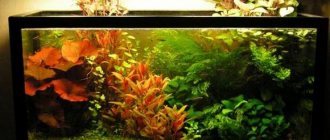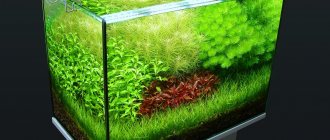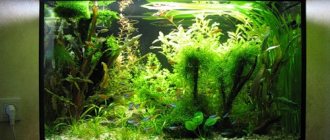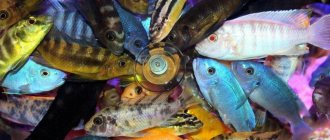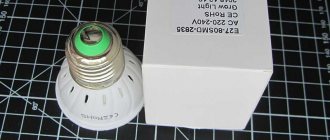Lighting functions
Light plays an important role in the production of oxygen by plants, which is necessary for the proper functioning of fish and other aquatic animals. Only in the presence of light do plants synthesize organic compounds from simple inorganic substances. In fish, light regulates basic life processes, such as feeding or spawning. An additional function of lighting is to provide a visual representation of the aquarium and its inhabitants.
Under natural conditions, the amount of light entering the tank depends on many factors: the angle of incidence of the light rays, the nature of the tank, the transparency of the water (affects the amount of absorbed and scattered light rays in the water), and the number of obstacles encountered. The streaks of color (which are part of the sun's rays) reaching the plants are also important. Plants need red and blue light.
Types of light sources used in aquarium keeping
Sun
A natural light source used to complement artificial lighting. If the sun were the only source of light, then during the winter months there would be a shortage of it, the vegetation would decrease, and therefore the fish too. It is not recommended to use sunlight or place the aquarium on a windowsill because this accelerates the growth of algae and temperature fluctuations between night and day.
fluorescent
Currently, artificial light source is widely used. During operation, they are very economical (including a long service life) and provide good illumination of the entire tank (about 15% of the energy is released in the form of light). They are available in various colors.
Mercury (high pressure) lamps (HQL)
They are characterized by high efficiency and low operating costs (unlike fluorescent lamps, they do not lose light intensity as quickly). Recommended for use in aquariums with a water level above 60 cm. Designed mainly for open aquariums (they should not be installed directly above the water level). When using strong light sources, the water in the aquarium must be enriched with carbon dioxide.
Metal halide lamps (HQI)
They are more suitable compared to mercury ones due to the more favorable color of the light. Also designed for large tanks, but requires additional spot lighting. They wear out quickly and heat up (but they do not heat up the water significantly). When using strong light sources, the water in the aquarium must be enriched with carbon dioxide.
LED lightening
This is the most expensive solution (purchase cost), but also the cheapest in terms of operating costs. Mainly used to illuminate the aquarium at night (in low light conditions).
Fertilizer dispenser for aquarium based on arduino
Fertilizer dispenser for aquarium based on arduino
Post by mikmuk » Jul 25, 2021, 03:49 pm
Project block diagram:
What it can do so far: 1. Turn on each can separately once a day with a multiplicity of 1 s. 2. Possibility to turn off any of the cans using handles. 3. Monitoring the level in each bank with filling icons shown. 4. Disabling dosing from the can when the level drops to a minimum. Moreover, the banks of phosphates and nitrates are connected. If one of them drops below the minimum level, both will turn off. 5. Possibility of manual pumping of each can. 6. Shows the temperature inside the control unit (just in case). 7. All settings are saved when the power is turned off.
A few more photos. Banks:
The motors haven't been soldered yet.
Internals with lid:
The display lights up only when the buttons are pressed.
General view during testing:
I'm not sure about the sonar's resistance to harsh environments, but otherwise it should work. Yes, and I’m not a programmer at all, so the program may be crooked and oblique
Fertilizer dispenser for aquarium based on arduino
Post by Hedin » Jul 25, 2021, 8:40 pm
Udo jars are a bad option. Udo, especially micro, will last a maximum of 3 weeks and will oxidize. I spent almost a year on this problem. Air is the main enemy of fertilizers. And, as always, the solution turned out to be very simple. Instead of cans and bottles, we take bags for blood transfusions, urinals, or regular ones for ketchup, mayonnaise, and agusha. We cut the intake tube hermetically into the lid. As a result, the udo is selected, the package is compressed and there is no mold in the udo or decay of microelements. Another find. It is best to terminate the supply hoses with check valves with needles from a syringe and lower them into water. Here we kill two birds with one stone: there will be no salting and the oud in the tubes will not oxidize.
In general, you have a well-thought-out design. They even provided for manual pumping. Here's another tip: after it runs out, bleed the system with water, and then with alcohol or Sidex. It’s also guaranteed not to be bad if you add just a little sidex to the macro. If macros are made from garden mixtures, mold often grows in the solution and clogs the system. And one last thing. Place the entire unit in an easily accessible place. Such systems require daily monitoring and inspection.
Source
Lighting for plants
When it comes to plant breeding, it is no secret that wavelengths of 400-450 nm and 650-700 nm are the best for proper photosynthesis, while waves around 550 nm are useless. The graph below shows the dependence of the photosynthesis process on the wavelength of light:
There are many fluorescent lamps on the market that are commonly used for plant breeding, such as: Philips Aquarelle, Osram Fluor, Sylvania Grolux, Hagen Aqua Glo, but their price is not the lowest. Let's see if this type of fluorescent lamp is worth investing in. Let's start by determining which light parameters are most important.
4.1. Lighting parameters.
Fluorescent lamps have the following parameters:
- index (RA or CRI) the maximum value of RA is 100. RA = 100 is the ratio of the sun. With RA from 80 to 90 we have good color rendition, and with RA over 90 we have very good color rendition. RAs less than 80 are rare. Below is a comparison of color accuracy between RA=70-100 and RA=30-50. You can see how RA=30-50 changes the color of the flowers.
- Color temperature (measured in Kelvin K) - white light from 5500 to 6500K. Below 5500K the lamp light turns yellow or orange, and above 6500K the light turns blue.
- Brightness (measured in lumens lm) is the brightness at which the human eye sees, which best sees wavelengths in the 500-600 nm range. The greater the amplitude of these wavelengths in the light spectrum, the brighter the light source to the human eye. However, it should be noted that if we compare two fluorescent lamps, one of which will have a higher amplitude in the wavelength range of 400-500 nm and the other 500-600 nm, despite the fact that they will produce the same amount of light, the brighter there will be a second eye.
- Power (measured in watts) is a parameter that reflects the actual amount of light that we have in the aquarium. Knowing this parameter, it is easy to calculate how many watts per liter in our aquarium (for example, having a 200 liter aquarium and two 35 W fluorescent lamps = from 70 W to 70/200 = 0.35 W / liter). Please note that the higher the wattage, the better the fluorescent lamp. When comparing the wattage of light sources, we always compare the same type of light, such as fluorescent lamps with fluorescent lamps, incandescent lamps with incandescent lamps, halogen lamps with halogen lamps.
RA, brightness and color temperature are not very important to plants, and the common belief that a lamp must have a low color temperature is just a myth. The second myth is that aquarium lights are better than regular fluorescent lights. Aquarium lamps are beautifully packaged and have fantastic names, but they are made using the same technology and their parameters are very similar to regular fluorescent lamps. However, a significant difference will be noticeable in price. It is true that there are better and worse fluorescent lamps, but I want to draw your attention to the fact that there are no fluorescent lamps that are not suitable for an aquarium and that can harm plants or fish. They all have a rich spectrum, and if plants do not grow well in an aquarium, factors for this state of affairs should be looked for in water parameters, access to nutrients (provided by fish or artificially grown with special fertilizers or pressed into a bottle with carbon dioxide) and lighting power, installed in an aquarium. Just ask aquatic plant manufacturers what kind of fluorescent lamps they use and you will see that most of them use the cheapest ones.
Shchitney – Triops
Classification. Phylum: Arthropods Subphylum: Crustaceans Class: Branchiopods Subclass: Phytopods Order: Shchitni (Notostraca - GO Sars, 1867) Family: Shchitni (Triopsidae - Keilhack, 1909)
Description. Shields or Triops are interesting small crustaceans that are common on almost all continents except Antarctica. They live, it would seem, in the most unsuitable conditions - in small, stagnant bodies of water that periodically dry up, in various ditches and even puddles that form after heavy rains or seasonal floods. In such reservoirs, scale insects often appear suddenly and in large numbers. However, despite their widespread distribution, shield insects are represented by a very small number of species. In Europe, the two most common species are Lepidurus apus (spring varieties) and Triops cancriformis (summer varieties). The former prefer cold bodies of water with temperatures up to 15°C, so they are found only in the spring, the latter are more thermophilic, so they appear in the summer. Several species are found in America - the most common are Triops longicaudatus and Triops newberryi. In Australia the species Triops australiensis is known, and in Africa Triops numidicus. But the species Lepidurus arcticus lives only in the Far North.
A total of 16 types were approved for 2008:
| genus Lepidurus (Leach, 1819) | genus Triops (Schrank, 1803) |
| Lepidurus apus (Linnaeus, 1758) Lepidurus arcticus (Pallas, 1776) Lepidurus batesoni (Lonhorst, 1955) Lepidurus bilobatus (Packard, 1883) Lepidurus couesii (Packard, 1875) Lepidurus cryptus (Rogers, 2001) Lepidurus lemmoni (Holmes , 1894) Lepidurus lynchi Lepidurus mongolicus (Vekhoff, 1992) Lepidurus packardi | Triops australiensis (Spencer & Hall, 1895) Triops cancriformis (Bosc, 1801) Triops granarius (Lucas, 1864) Triops longicaudatus (LeConte, 1846) Triops newberryi (LeConte, 1846) Triops numidicus |
Appearance. The shieldfish got its name due to its flat oval shield, which covers the head, chest and front part of the abdomen of this crustacean. In the front part of the shield, on a small tubercle, there are two black, closely spaced compound eyes. A little higher between them there is a small simple eye, which is called the naupliary. It is possible that this eye can only distinguish light from darkness and helps shield insects navigate in space. Behind these three eyes is a small and unusual four-celled organ whose function has not yet been determined. The back of the shield is semicircular with a slight elevation. Protruding from underneath is a thin, segmented abdomen, which ends in two long thread-like appendages. Some species have a so-called unpaired caudal plate between these appendages. In front, the scutellum bends down towards the ventral side, where it comes into contact with a rather large, almost square upper lip. The first and second pairs of shield antennae are very small and poorly developed, but the jaws are large with a large number of teeth. The mouth is located behind the upper lip, between the lower jaws. Also from the ventral side you can clearly see the numerous and unusual leaf-shaped legs of the shieldweed, of which some species can have up to 70 pairs! With the help of these legs, shieldfish swim, carry food to their mouths and even breathe! On the first segments of the abdomen, like other crustaceans, there is one pair of legs, but starting from the thirteenth, each segment no longer carries not one, but from 4 to 6 pairs of legs! The first and, to a lesser extent, the second pair of legs differ from the others, because bears four long, whip-like flagella that protrude beyond the scutellum. These flagella serve as sensory organs, and externally resemble the antennae of other crustaceans. The legs of the 11th pair in females are changed into a round capsule, where she lays eggs, and in which she bears them for some time. In males, the eleventh pair is no different from the rest. Starting from the anterior pair, the legs gradually decrease in size, and the last segments of the abdomen have no legs at all. It is interesting to watch the movement of the shieldfish's legs. While swimming, it moves all its legs simultaneously, creating wave-like movements with them. When the shield stops, the front legs stop moving, while the hind legs continue to move. This is important because the hind legs are primarily used for breathing (they have gills), while the front legs are used to move food to the mouth. Vision is also important for shieldfish. Interestingly, shield insects can perceive not only light from above, but also from below. This was proven by one experiment - when in a dark room an aquarium with scale insects was illuminated from below, they immediately turned over with their belly up: in this position, the complex eyes of the scale insect perceive light. The same thing happened even when the shield's compound eyes were covered with an opaque varnish. Apparently, they sense light thanks to a small nauplial eye, which continues down and ends on the ventral side with a small transparent “window”. The size of the scalefish is not large - on average about 4 cm. The size of the largest scalefish caught (T. cancriformis) was 11 cm.
Behavior and nutrition. Shields are active around the clock. They spend most of their time near the bottom, rummaging in the soil and looking for their food there. In this they are greatly helped by their whip-shaped sensory organs located on the first pair of thoracic legs. Shields eat almost anything that is smaller than them - particles of soil, small invertebrates or algae. Sometimes they also attack frog tadpoles and fish fry. If there is enough food, shield insects can eat each other.
Reproduction and development. Most populations of shieldfish, especially in our latitudes and in the north, are represented mainly by females, who reproduce by laying unfertilized eggs - cysts. It is not known exactly whether these females reproduce parthenogenetically or whether they are hermaphrodites. Males are very rare - in approximately 1% of populations. Interestingly, the number of males increases greatly from north to south, and in the tropics males even outnumber females. The female lays her eggs in the egg chamber on the abdomen, where they develop into embryos, and then the female lays the resulting cysts (a hard, well-protected capsule where the embryo is located) in the sand at the bottom of the reservoir. Soon after this, the adults die, and the cysts, even if the reservoir dries out, remain in the ground and will hatch under more favorable circumstances. Cysts have a very hard shell and can withstand even the most unfavorable conditions. No metabolism occurs in cysts. They are able to withstand prolonged drying out and freezing of the soil and remain viable for many years. In a dry and dark place, cysts are stored for decades and can withstand temperatures up to 80°C! Moreover, it was found that cysts often even require prolonged drying and freezing for the appearance of larvae. Cysts are carried by various animals to other bodies of water, and when dry they are carried by the wind. Thanks to this, today shieldfish are distributed almost throughout the world. When favorable conditions occur - for example, after heavy rains, when dry reservoirs are again filled with clean, oxygenated water, the cysts begin to “awaken.” It is known that to awaken they need several conditions - light, water, and the absence of other living organisms in the water. But even under the most favorable conditions, the cysts do not awaken all at once. Some remain in an inactive state in case the reservoir dries up too quickly and the younger generation does not have time to produce new offspring. If adult scale insects develop to adulthood, lay eggs and die (as a rule, this takes place in 6-12 weeks), and the reservoir does not dry out before this time, the larvae can emerge immediately, bypassing the drying stage. A few hours later, after the cysts find themselves in favorable conditions, tiny larvae, about half a millimeter in size, called nauplii, begin to hatch from them. The summer shield nauplii have a tiny, non-segmented body, 3 pairs of limbs and only one simple (naupliar) eye. In other species of shieldfish, the larvae emerge more developed with already existing segments on the back of the body - they are called metanauplii. Shield larvae feed mainly on bacteria and other protozoa. Given enough food, they grow very quickly and shed every day. After just 5 days, nauplii of the species T. Cancriformis reach the size of a pea, and after another ten days, already 1.5 - 2 cm long, they can hatch their first eggs. The lifespan of shieldfish is very short - Triops longicaudatus live about 50-60 days, Triops cancriformis - 90 days. Such a short life is completely justified, because... The reservoirs in which shieldfish live do not last long and quickly dry up, and before this happens, shieldfish must have time to grow and give rise to their new offspring.
Keeping it in an aquarium. Shields are quite unpretentious animals and keeping them in captivity is not difficult. They are not very picky about water quality and temperature, and they can eat almost any plant or animal food they can find. Only in the first days of life does the younger generation need to be provided with special conditions. The cysts deposited on the bottom of the aquarium must be collected, cleaned of silt and dirt and dried for some time. After this, they should be placed in a small container (preferably no more than 2 liters) and filled with clean distilled or spring water. Under these conditions, the larvae hatch very quickly - usually within a day or even faster. If you use old water from the aquarium, the larvae may not hatch or their release will be greatly extended over time. The larvae must be kept in well-aerated and illuminated water with a small amount of sand at the bottom. The larvae feed on various tiny microorganisms, which are usually included with the housing kit when purchased. However, you can dilute the food yourself - to do this, place dry leaves, carrot juice or a few drops of manure sludge in the water. All this must lie in water for at least 24 hours. Then the water becomes cloudy - this means that all the necessary microorganisms that young triops need to feed have developed in it. You can safely release newly hatched crustaceans into such water. In the first three days after hatching, it is advisable for the larvae to be provided with continuous lighting, because Without this, it will be very difficult for them to find food, and they may die of starvation. This is important only in the first three days, when the nauplii are still very small. Then on the fourth day, when they are old enough, the light can be turned off. At this time, if there is enough food, the larvae grow very quickly, sometimes molting twice a day. It was noticed that in large groups, scale insects develop much more slowly and reach smaller sizes than those that develop individually. Therefore, in the first stages, it is better not to contain more than 5 shieldfish in one container. You can feed growing and adult individuals with aquarium food - bloodworms, tubifex, daphnia and other dried and combined foods. If a bloodworm or tubifex burrows into the ground, shieldworms can easily remove it from there. They can also eat blue-green algae that appears on the glass of the aquarium. In general, it is very interesting to observe the behavior of shieldfish in the aquarium. They constantly swim in different directions, swarm in the ground, and turn over. Sometimes lying upside down and holding food with their paws, they eat and turn it over all the time. All this makes shieldfish a very interesting and popular pet, and in Europe they even have a whole industry for the production of aquariums and other special equipment for their breeding. We recommend reading a detailed and interesting article about the launch and maintenance of triops on the website zoobot.ru.
The color of the lighting depends on the color temperature of the fluorescent lamps.
If you are wondering which tint fluorescent lamps have different temperatures, the following spectral chart will be useful.
The aquariums are presented below, after illumination with various brands of fluorescent lamps appearing on our market with different color temperatures.
2700 K 3000 K 4000 K 5200 K
6500 K
8500 K
10000 K
15000 K
18000 K
As we can see, the color of the light matches the colors on the spectral diagram. If one would like to get a nice effect of some color in the aquarium, then you can easily go to the store and buy a fluorescent lamp with the desired color temperature. You can mix two different fluorescent bulbs to create a color combination.
ATTENTION!. Some fluorescent lamps cannot be used alone as they may affect algae growth, so mixing two fluorescent lamps with different color temperatures is used.
For spare parts:
| 1. Arduino nano 3.0 with Atmega 328p on board | Ali link: Buy |
| 2. Display 2004 with I2c module |
For installation you will need wires, connectors, breadboards for assembling drivers, and soldering supplies:
| Ali link: Buy | |
| 1. Excellent installation wire | Ali link: Buy |
| 3. Good solder | Ali link: Buy |
| 4. Development boards | Ali link: Buy |
| 5. No-clean flux RMA 223 | Ali link: Buy |
| 7. Soldering iron with temperature control | Ali link: Buy |
Fluorescent lamps T5 and T8. Which to choose?
Both T5 and T8 fluorescent tubes are available in the market. I will try to present the differences between them:
- They differ mainly in the T8 diameter of 26 mm and the T5 diameter of 16 mm.
- Length For example, T5 with 24W is 55cm long and T8 with 25W is 74cm long.
- T5 has longer run time compared to T8
- T5 has greater efficiency, that is, more energy efficient
- T5 is more expensive than T8, depending on the manufacturer from 10% to even 130%
- T5 requires special electronic ballast, which is not cheap, which increases the cost of the entire installation. The advantage of this ballast is energy saving and flicker-free.
It follows that buying T5 is a good choice in terms of performance and benefits - small size, high efficiency, long service life. However, the price difference compared to the T8 is significant. So before you buy, you should think about it. When choosing, remember that T8 fluorescent lamps T5 fields are stored in terms of the light spectrum, and the RA ratio. They have slightly lower vitality and potency, but also produce good fish colors and induce plant growth.
Budget automatic fertilizer dispenser
Budget automatic fertilizer dispenser
Post by Slavkin » 20 Nov 2011, 08:51
Budget automatic fertilizer dispenser
Message by friend » November 20, 2011, 09:19
Budget automatic fertilizer dispenser
Post by dimetrius » 20 Nov 2011, 15:19
Budget automatic fertilizer dispenser
Post by flicker » 20 Nov 2011, 18:56
Budget automatic fertilizer dispenser
Post by Slavkin » 21 Nov 2011, 06:12
Budget automatic fertilizer dispenser
Post by flicker » 21 Nov 2011, 14:57
Budget automatic fertilizer dispenser
Post by Slavkin » 21 Nov 2011, 15:09
Budget automatic fertilizer dispenser
Post by flicker » 21 Nov 2011, 15:33
Budget automatic fertilizer dispenser
Post by Slavkin » 22 Nov 2011, 05:43
Budget automatic fertilizer dispenser
Post by Slavkin » 26 Nov 2011, 15:02
The second version of the dazator is in the process of being manufactured, taking into account my experience and discussion on the forum. The first version works without problems, about 200 passes were made.
In the second version I use a ball bearing (secured in a clip for a T5 lamp), smaller volume syringes (5 ml) and a smaller motor. The device turns out to be more compact, hopefully not at the expense of reliability. The engine is from an Epson inkjet printer, engine model EM-529 RS445PA14233R, operating voltage range: 12-42 V, but reliably moves the pistons even at 8 volts. The screw pair was taken from M5 (in the first version M6), since the found bearing just fit the diameter of 5 mm, and it was easier to connect the M5 screw to the motor shaft. The nut for the screw pair was purchased at a hardware store; it was not difficult to secure it in the syringe rod pusher. I haven’t installed the limit switches yet, but everything works. To be continued.
Source
Ballasts - types and advantages
The following ballasts are available on the market:
- Magnetic balancers, also called induction balancers, are primarily used for T8 fluorescent lamps in combination with starters (also called starters). Their main advantage is price. They are several times cheaper than electronic ballasts
- Electronic ballasts have been used for T5 fluorescent lamps and recently also for T8 fluorescent lamps. Electronic ballast does not require the use of starters. The advantages of electronic ballasts over magnetic ones are, first of all, electricity consumption (about 15%), they eliminate the flickering effect of light, increase the working time of pigeons by up to 50% and emit less heat during operation.
Designations 865, 965, 840, 930, what is it?
These markings have RA coefficient and color temperature encoded into them. for example, Philips 840 means the RA is greater than 80 and less than 90 (number 8), and the color temperature is 4000K (number 40). Another example of 965 means that the RA is greater than 90, which is very good, and such fluorescent lamps cost more than eight, and the color temperature is 6500K. Sometimes there are slight differences, such as NARVA BIOVITAL 955, which has a color temperature of 5800K rather than the number indicating 5500K. Therefore, for an accurate estimate of the temperature coefficient of temperature and RA, please refer to the fluorescence documentation or the manufacturer's website.
Determining the required lighting power
There are different rules for determining the required lighting power. The old Ringwald rule states, for example, that per 1 dm2 of tank bottom area there should be 0.75 W of fluorescent lighting or 2 incandescent lighting (this applies to a 30-liter tank). Another rule is that 1 liter of water requires a lighting power of 0.5 W. In fact, it all depends on the depth of the aquarium and what we will grow in it. For densely populated aquariums, it was suggested that lighting should be around 0.6 W/L of water. It is very important to maintain the correct balance between lighting power and the amount of nutrients available to the plants. We will waste extra light if we do not provide enough nutrients for plants.
When choosing lighting, you should not suggest the number of lumens the light source produces, since the number of lumens does not reflect the actual number of photons emitted and only the subjective impression of the human eye. The more lumens, the human eye notices that the light is brighter. The human eye, however, can be deceived, and brighter light does not always mean that there are more photons emitted. To determine the amount of light needed, you need to take into account one more parameter - the number of watts or light power. You can also use reflectors to reduce losses. These are aluminum covers with a high mirror finish for fluorescent lamps that direct all the light downward while maintaining the least loss. Thanks to this, you can use up to 30% less light power. These are not expensive toys, and the effect they create is visible to the naked eye :). You also need to make sure that the surface of the water is not static because it will act as a mirror, reflecting light and causing loss. Filters and aerators that create air bubbles that break and move the water mirror are the best.
Note. When using strong lighting, it is necessary to provide plants with carbon dioxide and nutrients in large quantities. However, care must be taken not to upset the biological balance. When there is an excess of nutrients that are not used by plants, algae growth will occur.
Fertilizer dispenser for an aquarium using Arduino and peristaltic pumps.
So the need for an auto dispenser has arrived. I'm tired of pouring 4 different solutions every morning.
As usual, the project will be cheap, simple and reliable. And of course it was assembled on Arduino.
The project is open, the source code is in the topic on our forum. When repeating a project, we kindly ask you to indicate the original source www.aquakmv.com. Well, share your improvements in this topic. I will be very grateful!
I chose 4 independent channels for peristaltic pumps. Each can be configured for a specific response time and set how long the pump will operate in seconds. Using simple calculations, you can calculate the productivity of the pump ml/sec and, based on this, set the duration of operation. For example, to pour 30 ml of potassium, the pump must run for 28 seconds.
We will display everything on a 2004 display connected via an I2c bus.
Control of one encoder. The menu is cyclical, transition by turning the encoder. To change the value, you need to press the encoder and, without releasing it, turn it in the desired direction.
A few tips when installing lighting
To keep the lighting in the aquarium as close to natural as possible, it is recommended to use mixed lighting (for example, red and blue fluorescent lamps, warm and cool fluorescent lamps). It is important that the aquarium is lit for 12-14 hours over a 24-hour period. We fix the light source(s) in an aquarium housing (purchased from a pet store or handmade), insulate its interior with aluminum foil, paint it white, or mount it inside a mirror (reducing light loss). The length of the fluorescent lamps should be shorter than the aquarium only by attaching them to the lid. The lighting should be stronger (higher power) at the front of the aquarium (the plants will lean towards the glass of the aquarium). Replace fluorescent lamps with new ones from time to time due to their burnout (reduction of light intensity).
